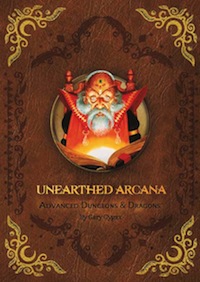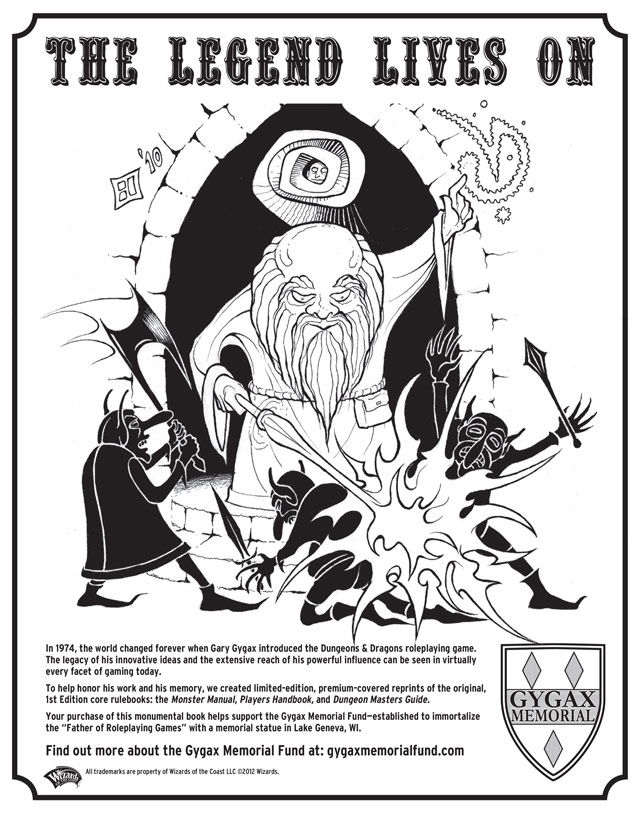For me, Unearthed Arcana is where it all started. Not playing Dungeons and Dragons, or roleplaying games in general—the classic “red box” and Palladium’s Teenage Mutant Ninja Turtles and Other Strangeness took care of that—but really understanding the game, really deciding to run a game: that starts here.
The three core books of D&D are the Player’s Handbook, that has the stuff on being a half-orc and a paladin and what have you, the Dungeon Master’s Guide, which gives you the rules for traps, advice on how to pretend to be fifty townsfolk or build a continent, and magic items, and Monster Manual which as you may have surmised contains rules for monsters. What Unearthed Arcana did was…well, break the rules. Break the mold.
I had one of those childhoods where I had to keep my Dungeons and Dragons playing on the sly. The moral panic of the 80s was in full swing, and anything with a picture of a monster on it was just one more shred of evidence that I was doomed to…I don’t know, become a Russian spy and live in steam tunnels as part of a cult? “It’s my fault Black Leaf died!” The fabricated “controversy” over the game obviously doesn’t make a lot of sense, but it meant there was no way for me to get ahold of Dragon magazine, which meant that the first time I read an old Unearthed Arcana was the first time I saw, well, really any new rules.
It was more than that though; it was the first time I really grokked the nature of the game. “Wait a minute,” said little Mordicai, “I can just make up new rules?” So yeah, obviously I then became addicted to tinkering, to house rules, to re-inventing the wheel and fiddling with the game in fundamental ways. I follow pretty weird ideologies as a Dungeon Master, and ultimately I credit a dog-eared library copy of Unearthed Arcana with opening my eyes; well, that and the AD&D Tome of Magic, both of which I discovered around the same time. Wild Magic? Cavaliers? Heck yes.
So what do we get, here? Well, right off the bat, Comeliness, the “seventh” attribute, a measure of…physical attraction. Lots of information on playing subraces and cross-indexing them with better rules for class level limits. Cavaliers (I really like the percentile attribute increase mechanics), Barbarians (the magic-hating kind), Thief-Acrobats (and new retconned falling rules) and a bunch of new mechanics for some traditional classes, like double-specialization for Fighters. Subdivided items to the Nth degree including infamous rants about polearms, spells and spells, magic items, non-human gods, and optional rules that herald the mass confusion spell of grappling rules. A lot of stuff is in here.
Going over it again in the pretty premium edition, I find my feelings about the reprints of the core books confirmed. There is a lot of stuff to get inspired by here. Strip it down to system neutral and just look at the ideas. Turn over the rock and look at the roots to find…well, really good ideas. I’ve always had a thing for the belt of dwarvenkind. You know, the cloak of elvenkind rules, obviously, and my last character had one, but they’re just cribbed from Lord of the Rings. Homage, that’s the word for it. It makes me want to look at the belt of dwarvenkind as a kind of parallel reality, where The Fellowship rest and recuperate at the Lonely Mountain instead of Lothlórien. Or the cloak of arachnidia, the slippers of spiderclimb, what about a drow Galadriel? The Robe of Vermin; I used one in a game actually based on this; it was a cursed item but it was worn by a cultist of a god of filth, so they were immune to the curse and got the pluses—I always thought most cursed items were implausible, so I really liked my backstory.
I’m a sucker for non-human pantheons; I like the idea that there are these other cosmologies, that the traditional paradigm of human gods don’t know anything about. If you asked me, I’d make the Seldarine deities their own faerie powers, not just defined by being the gods of the elves; while dwarven gods are maybe a secret, hoarded by the devout race of dwarves who honor them by growing their beards, or whatever. Specific gods are…well, specifically cool. I like fourth edition’s Moradin a lot—half Hephestus, half Thor—but there are guys like Vergadain, the dwarven god of poetry and non-evil thievery, who vibe Viking dualism, or the creepy hairless mole rat Urdlen who embodies gnomish malice and greed; hook that guy up with some Derro cultists and you are in business.
Oh and orcs! Gruumsh mythology is in here—after being cheated by the gods, he stabbed the mountains, and the orcs grew in the caves, he pierced the hills and the meadows and from those gouges, his people came. Bahgtru, the Brute, like Kalibak, defeater of Godzilla. Shargaas, the Night Lord, the skulking Grendel, assassin. Ilneval, the Champion, lieutenant of Gruumsh, representing the rise of militarized civilization among the orcs. Yurtrus White Handed, who is death and disease, Luthic who is fertility, caves and medicine…just look, all of that is gold, you could build a whole orcish civilization based on those domains, and it would feel organic, it would feel detailed and real.
The third edition of Unearthed Arcana really blew the lid off of the Open Game License and gave people like me—and maybe you, if you like tinkering under the hood as well—a host of tools and parts to mess with the Dungeons and Dragons engine. That wouldn’t have happened without the AD&D Unearthed Arcana, and besides that, the book planted the seeds for much of what Dungeons and Dragons has become over the years. Owning this as a piece of history is all well and good, but the thing that clinches it is…well, the fundamentals are still sound. The ideas in here are still ripe, still solid points of inspiration for your next magic item or weird dungeons; even if you don’t play an old school edition.
Remember; part of the proceeds go to the Gygax Memorial Fund!
Mordicai Knode has said it before, but he’s Team Spider and Team Galadriel…making Team Drow Galadriel really appealing. You can find him on Twitter or Tumblr.











